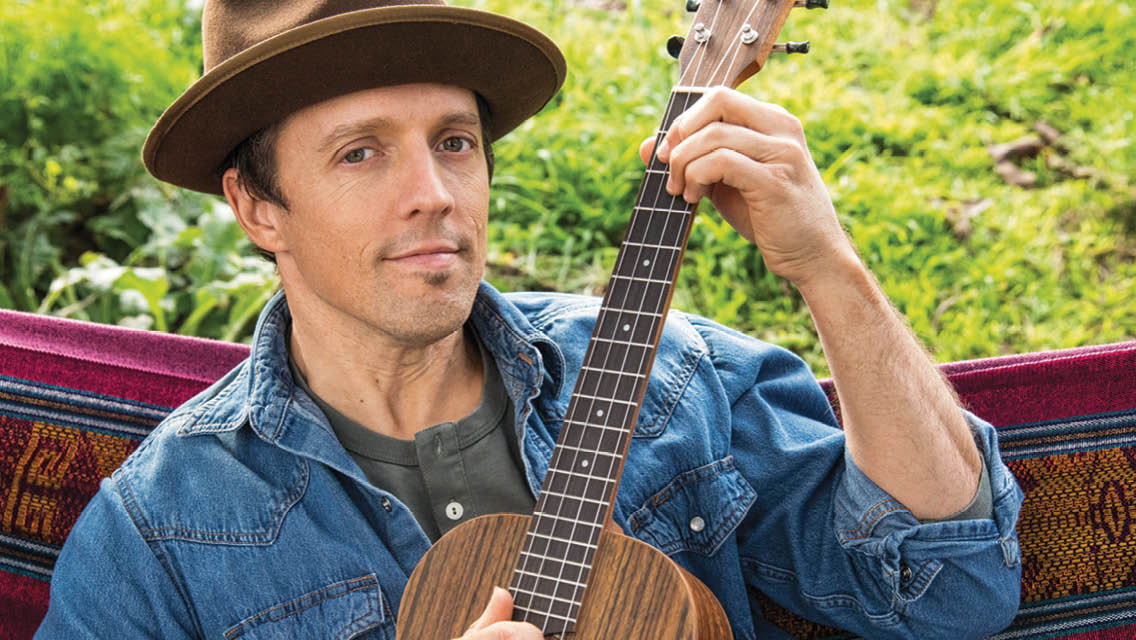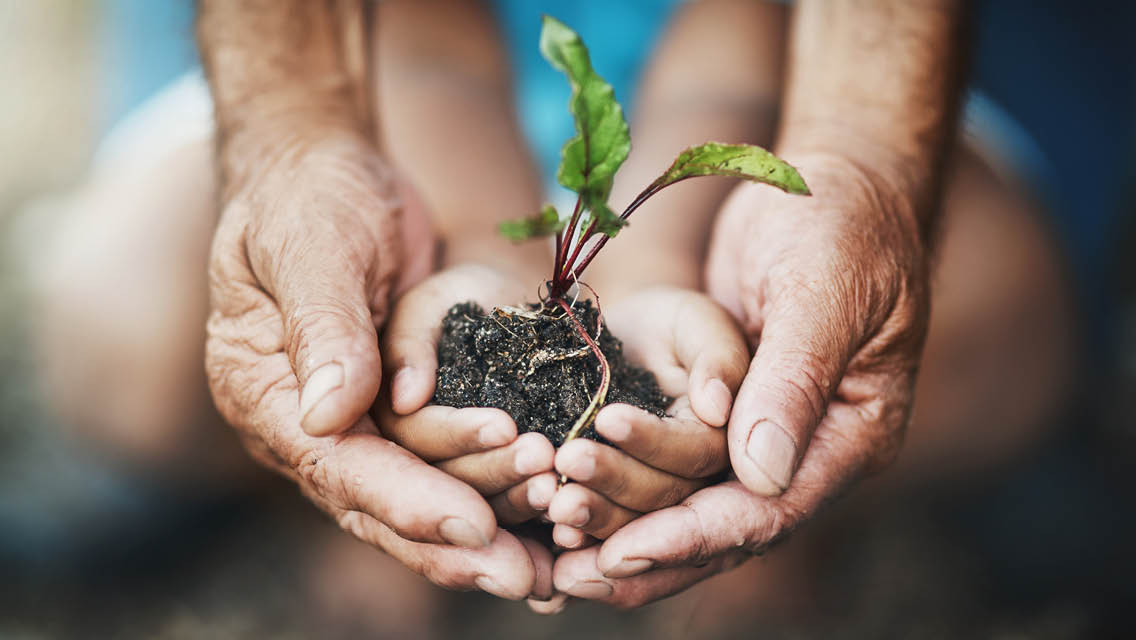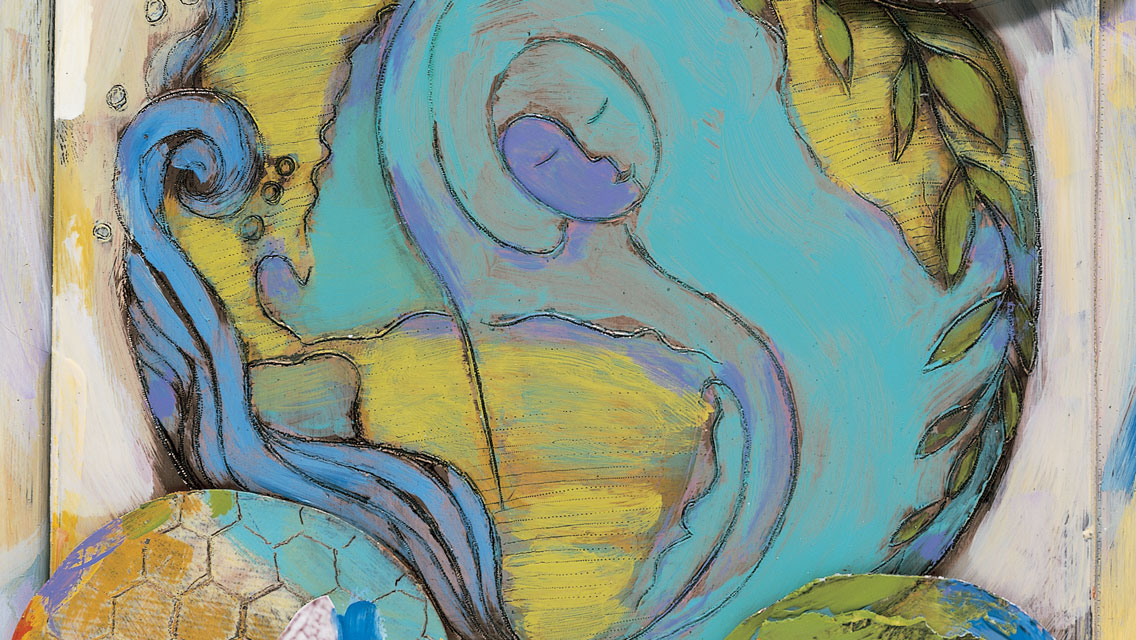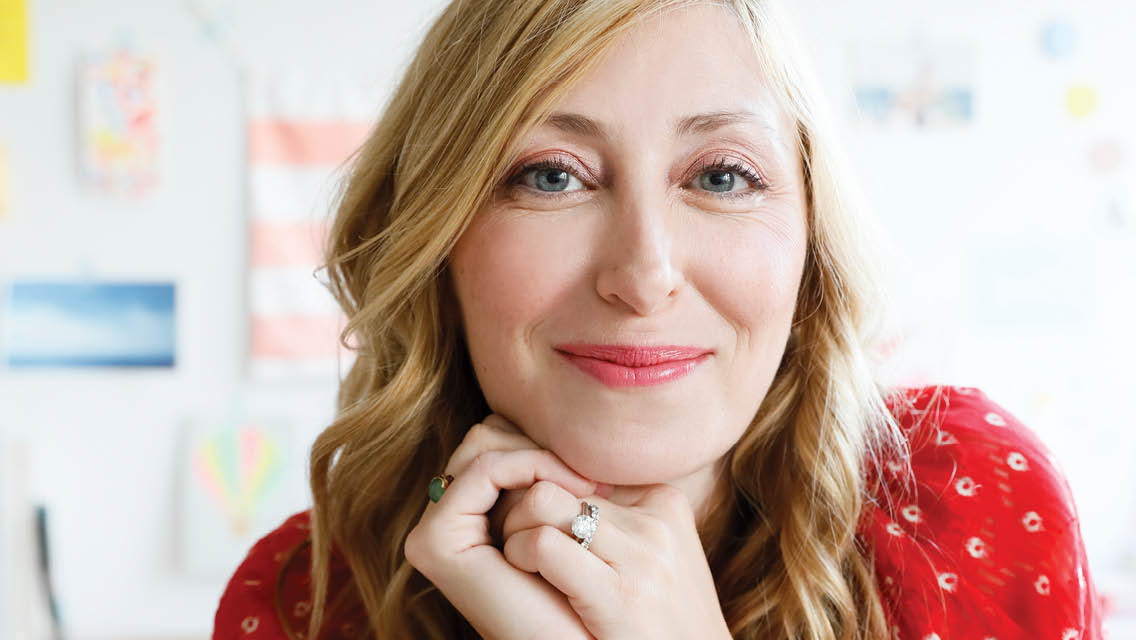To keep calm and relax during these stressful times, Jason Mraz likes to wake up early, make a cup of hot lemon water, then unroll his yoga mat for a 20-to-30-minute routine of breath work, stretching, and strength work. “Yoga is my meditation,” says the two-time Grammy-winning singer/songwriter.
Although he completed a 200-hour yoga-teaching training course in 2015, he’s never actually taught a class. “I wanted to learn the foundations so that I could do it myself when I was traveling all over the world.”
Like other artists, the prolific touring musician — he’s done almost 1,000 live shows worldwide in his 20-year career — pressed pause on performing in 2020 and early 2021 because of the pandemic. Like most everyone else, Mraz also stayed close to home, which for him is a magical piece of land he calls the Mranch, his 18-acre avocado, fruit-tree, and coffee-bean farm and recording studio about 45 minutes north of San Diego in Oceanside, Calif.
In a Zoom call from the peaceful property (where we took the photos for this cover story), Mraz says, “Anything that happens on the farm and in the garden is a great de-stresser.”
 When Mraz bought and moved onto the ranch in 2004, he says, it was “a modest little mission-style hacienda with five acres of all Hass avocados planted in the early ’70s.” Because he wasn’t a farmer, he enlisted a grovemanagement company to maintain the property while he continued writing and recording music on the ranch and touring.
When Mraz bought and moved onto the ranch in 2004, he says, it was “a modest little mission-style hacienda with five acres of all Hass avocados planted in the early ’70s.” Because he wasn’t a farmer, he enlisted a grovemanagement company to maintain the property while he continued writing and recording music on the ranch and touring.
In 2008, the farm-to-table food movement was gaining mainstream awareness, and Mraz bought a few neighboring farms, expanded the orchard, and planted a variety of fruit trees. In 2012 he went totally organic, and by 2015 he was lured into planting coffee by his then-wife, Christina Carano, a longtime java enthusiast and coffee-shop owner. (Although their marriage has since come to an end, they remain friends and are still partners in the farm.)
“One day, more than two thousand coffee trees showed up at our door,” says Mraz, “and that’s when I officially turned my backyard into the Mraz Family Farm.”
Although he considers himself a “gentleman farmer,” Mraz is still best known for his music, and he’s been making albums consistently since his 2002 debut studio album Waiting for My Rocket to Come and his first hit single “The Remedy (I Won’t Worry).”
The summer of 2019 found him busy writing uplifting reggae tunes for his seventh studio album. Optimistic songs of hope, gratitude, and love poured out of Mraz’s soul, culminating in a collection of music fittingly titled Look for the Good. “I knew 2020 was going to be heated because we were entering another election year, and I wanted to be a voice in that debate, to help us ‘look for the good,’” he explains. “And then things got bad.”
Just as he was finishing up the album, the pandemic hit. Then George Floyd was murdered, and protests were happening across America. “I felt like we were having this incredible awakening in our country,” says Mraz.
Initially he considered not releasing the album. “I wanted to put it on hold. I didn’t feel like this was my time to be jumping out on the internet or the world stage and saying, ‘Look at me! I’ve got a new album!’”
Instead, the longtime activist made a different kind of statement: “I decided that whatever money this record generates, I’m going to donate to organizations on the frontlines of this radical transformation that’s long overdue in our country.”
He released the album on June 19, 2020 — Juneteenth, the day commemorating the end of slavery in the United States in 1865 — and donated every dollar of the album’s earnings (including his advance) to organizations and movements championing equality and justice.
“We’re healing together,” Mraz acknowledges. “2020 showed us what was important, where there were wounds that needed to be addressed, sins that needed to be atoned for, and apologies that needed to be issued.”
He rereleased Look for the Good with additional songs in 2021, which generated more funds to those causes. “I want to inspire other leaders in business and other leaders in music to do the same.”
Q&A With Jason Mraz
Experience Life | Tell us about growing up in Mechanicsville, Va. Did you have a lot of farms around you?
Jason Mraz | I had two households when I was young — my mom was more suburbs, my dad was more rural. But both of my grandparents had fruit trees in the backyard that we were climbing, and gardens where we were picking the okra, which we despised. We were surrounded by fields of rotating crops of corn and soybeans, so it was always in the landscape. It was always something that I saw and was aware of, but I didn’t anticipate farming myself when I got older. I just wanted to be onstage playing music.
EL | How did you start performing?
JM | My mother enrolled me in afterschool programs, specifically one in Richmond called SPARC, which stood for the School of the Performing Arts in the Richmond Community. It was a fun place to use our imaginations and sing songs and dance and do goofy stuff.
When I was in my 20s, my mom revealed to me that I had gone to those programs on scholarship; otherwise she wouldn’t have been able to afford those classes. It made me aware of how powerful and important it is to have donors support these programs. As soon as I was able, I started donating to SPARC at that very same school where I’d gone.
EL | Is that what inspired you to start the Jason Mraz Foundation in 2011?
JM | Yes, that was really the seed for creating the foundation, which had a lot of different pillars when it began. Over the years, I’ve continued to narrow it down to programs I feel connected to. Today it provides funds and grants for inclusive arts education, food security, and the advancement of equality.
So far, we’ve donated more than $1 million, and last year, we awarded 33 $2,000 grants to nonprofits. We’re hoping to double that in 2022. But it all started because I myself was a recipient of those little donations.
EL | Was “SHINE,” the live concert show you did in early 2020, an outlet of supporting arts programming?
JM | Yes! “SHINE” is a big musical talent show involving the kids connected to different local organizations and programs the foundation provides grants to. Before the pandemic, in February 2020, we did two shows in San Diego. It was a really sweet show because we provided the music, but the kids provided [their] art for the songs. Some danced, some painted, some played or sang songs with us. The show gave everyone a chance to shine.
EL | Are you working on new music now?
JM | I’m currently writing music and hopefully will record later this year.
EL | Why did you decide to build your recording studio on the Mranch?
JM | In 2004, I visited Bob Marley’s house on Hope Road in Jamaica. It revealed to me what was possible for a musician’s home: a place where both music and food was grown. I also liked the idea of living in the country to have more room for sound.
Shortly after that trip, I started searching for a home outside of L.A. and San Diego. I found this quiet little avocado ranch somewhere in the middle. I didn’t dive right into farming, but I knew it was something I would grow into. I can also credit some of the artists behind Farm Aid — Willie Nelson, Neil Young, Dave Matthews — who I started paying attention to at the time. I admired them and chose to follow in their footsteps.
EL | Besides music and avocados, what are you growing on the farm?
JM | We have 40 different fruit varieties, including citrus, passionfruit, and bananas. But we were looking for a commercial crop, and that turned out to be coffee. My former wife, Christina, was the inspiration, because it grew out of her understanding of being a barista and a coffee-shop owner, and my career began singing in coffee shops around San Diego. We saw that commonality and partnered up.
We now have 11 different varieties of coffee, with a large portion being Geisha. Named after the Gesha region in Ethiopia, where the plant is thought to have originated, it stands out for its finish. It’s probably the smoothest cup of coffee discovered so far. We have customers who are collectors of Geisha — it’s that good.
EL | What are your hopes for the future?
JM | I’m in a constant state of “what’s next,” so in 2019 I brought my teams together — the music team, the farm team, and the foundation team — and we wrote a “vision statement,” which helps us find purpose and remember why we do what we do. We all wrote it together, solidifying what we’re striving for and the world we want to live in:
“Our vision for 2030, our vision for a future, is that a global shift in consciousness has occurred in which all people have the same right and opportunities to grow, love, and learn. Dreams are being fulfilled. Regeneration is the model for living, working, and playing. A new paradigm for health and well-being prevails. Mother Earth is honored. Communities are thriving and supporting each other, infused with, and celebrating the magic of, the arts. People are contributing their unique gifts and experiencing freedom, wholeness, and joy. Life is inspiring.”
The very definition of “inspiring” is to breathe life into things, and I can breathe life into these projects and ideas, which is truly fulfilling.
On the Cover
For more intimate, thought-provoking profiles of our inspiring and influential cover subjects, visit our On the Cover department.
This article originally appeared as “Seeds of Hope” in the April 2022 issue of Experience Life.





This Post Has One Comment
Jason has been, a very true comfort, through out many years, his songs, seem to come into my life, just as I needed them. His voice, words, playing, have affected me in a positive way♥️🙏💯.
Thank you for sharing your presence.